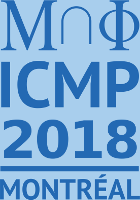Systèmes intégrables
- Marco Bertola (Concordia University, Montreal, Canada and Area of Mathematics, SISSA, Italy)
- Jean-Michel Maillet (LPENSL, ENS de Lyon and CNRS)
- Jeudi 26 juil [cartier i & ii]
- 14:00 Nicolai Reshetikhin (University of California), Semiclassical asymptotic for integrable systems and the Poisson sigma model
- 14:30 Vladimir Bazhanov (Australian National University), New advances in Quantum Field Theory in two-dimensions.
- 15:00 Karol Kozlowski (ENS de Lyon), Singularities of dynamic response functions in the massless regime of the XXZ chain
- 15:30 Evgeny Mukhin (Indiana University-Purdue University), Duality of quantum toroidal algebras and quandum KDV flows.
- Vendredi 27 juil [cartier i & ii]
- 15:15 Oleg Lisovyy (Université François Rabelais), Painlevé functions, Fredholm determinants and combinatorics
- 15:45 Paul Zinn-Justin (University of Melbourne), From quantum integrability to Schubert calculus
- Nicolai Reshetikhin
University of CaliforniaSemiclassical asymptotic for integrable systems and the Poisson sigma modelSemiclassical eigenfunctions of an integrable system can be regarded as a path integral for the topological quantum mechanics or as a path integral for the Poisson sigma model. This allows to compute semiclassical asymptotic of eigenfunctions in all orders of the semiclassical expansion in terms of Feynman diagrams of the Poisson sigma model with appropriate boundary conditions. This is a joint work with A. Cattaneo and P. Mnev. - Vladimir Bazhanov
Australian National UniversityNew advances in Quantum Field Theory in two-dimensions.In this talk we revisit some unsolved problems of Quantum Field Theory, in particular, the canonical quantization of two-dimensional non-linear sigma models (NLSM) in two dimensions. On the example of the O(3) NLSM and its one-parameter deformation --- the sausage model, we show how the long-standing "non-ultralocality" problem can be resolved. Our consideration is based on the continuous version of the the Quantum Inverse Scattering Method enhanced by a powerful ODE/IQFT correspondence, which connects stationary states of Integrable QFT models with special solutions of classical integrable equations. This approach leads to new efficient methods for computation of vacuum eigenvalues of the continuous analogs of quantum transfer-matrices in QFT. We also discuss the emergence of the Yang-Baxter Poisson algebra in other non-ultralocal systems related to the Principal Chiral Field models. - Karol Kozlowski
ENS de LyonSingularities of dynamic response functions in the massless regime of the XXZ chainDynamic response function correspond to space and time Fourier transforms of dynamical two-point functions and are thus functions of the momentum $k$ and energy $\omega$. Starting from the large-volume behaviour of the form factors of local operators and building on certain hypotheses relative to the existence of thermodynamic limits, I have constructed a series of multiple integrals representing the dynamic response functions in the massless regime of the spin-$1/2$ XXZ chain.
In this talk, I will describe a rigorous technique allowing to analyse and fully describe the behaviour, in the $(k,\omega)$ plane, of each multiple integral building up the mentioned series of multiple integrals. In particular, the method unravels the presence of singularities in the $(k,\omega)$ plane along certain curves $\omega=\mathfrak{e}(k)$.
This analysis confirms the predictions for the singular structure of the response functions that were argued earlier by means of a heuristic approach based on putting the model in correspondence with a non-linear Luttinger Liquid. It also stresses the importance of the role played by collective, equal velocity, excitations on the generating mechanism of the singularity curves and the associated edge exponents. Finally, this analysis sets a very simple picture allowing one to reduce the manifestation of universal features characteristic of the Luttinger Liquid universality class to the presence of certain singularities in the large-volume behaviour of form factors of local operators and to consequences of a classical asymptotic analysis of multiple integrals.
- Evgeny Mukhin
Indiana University-Purdue UniversityDuality of quantum toroidal algebras and quandum KDV flows.We prove the $\mathfrak{gl}(n)- \mathfrak{gl}(m)$ duality of quantum integrable systems associated to quantum toroidal algebras. Conjecturally, in the case of $n=1$ and $m=2$, in the conformal limit, the $\mathfrak{gl}(1)$ integrals of motion become the quantum KdV flows and the $\mathfrak{gl}(2)$ integrals of motion become the corresponding non-local integrals of motion defined by Bazhanov-Lukyanov-Zamolodchikov. We discuss the corresponding Bethe ansatz.
- Oleg Lisovyy
Université François RabelaisPainlevé functions, Fredholm determinants and combinatoricsI will explain how to associate a tau function to the Riemann-Hilbert problem set on a union of non-intersecting smooth closed curves with generic jump matrix. The main focus will be on the one-circle case, relevant to the analysis of Painlevé VI equation and its degenerations to Painlevé V and III. The tau functions in question will be defined as block Fredholm determinants of integral operators with integrable kernels. They can be alternatively represented as combinatorial sums over tuples of Young diagrams which coincide with the dual Nekrasov-Okounkov instanton partition functions for Riemann-Hilbert problems of isomonodromic origin.
- Paul Zinn-Justin
University of MelbourneFrom quantum integrability to Schubert calculusWe shall discuss some applications of exactly solvable models of two-dimensional statistical mechanics to the theory of symmetric polynomials and to Schubert calculus. So doing we shall encounter various remarkable combinatorial models, such as tilings, pipedreams and puzzles.


